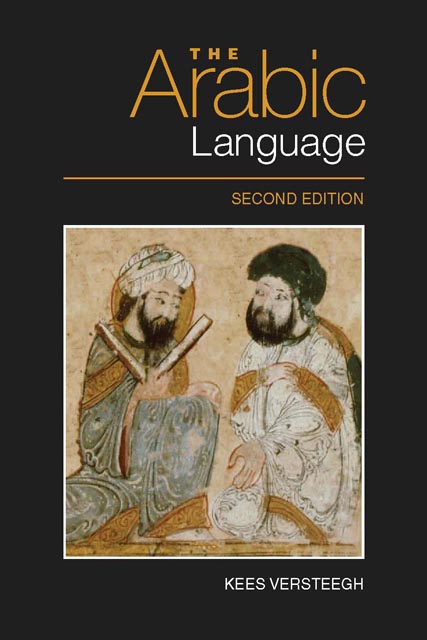Book contents
- Frontmatter
- Contents
- Preface to First Edition
- Preface to Second Edition
- List of Figures and Maps
- List of Tables
- Note on Transcription and Glossing
- 1 The Study of Arabic in the West
- 2 Arabic as a Semitic Language
- 3 The Earliest Stages of Arabic
- 4 Arabic in the Pre-Islamic Period
- 5 The Development of Classical Arabic
- 6 The Structure of Arabic
- 7 The Arabic Linguistic Tradition
- 8 The Emergence of New Arabic
- 9 Middle Arabic
- 10 The Study of the Arabic Dialects
- 11 The Dialects of Arabic
- 12 The Emergence of Modern Standard Arabic
- 13 Diglossia
- 14 Bilingualism
- 15 Arabic as a Minority Language
- 16 Arabic Pidgins and Creoles
- 17 Arabic as a World Language
- Bibliography
- List of Abbreviations
- Index
2 - Arabic as a Semitic Language
Published online by Cambridge University Press: 18 November 2022
- Frontmatter
- Contents
- Preface to First Edition
- Preface to Second Edition
- List of Figures and Maps
- List of Tables
- Note on Transcription and Glossing
- 1 The Study of Arabic in the West
- 2 Arabic as a Semitic Language
- 3 The Earliest Stages of Arabic
- 4 Arabic in the Pre-Islamic Period
- 5 The Development of Classical Arabic
- 6 The Structure of Arabic
- 7 The Arabic Linguistic Tradition
- 8 The Emergence of New Arabic
- 9 Middle Arabic
- 10 The Study of the Arabic Dialects
- 11 The Dialects of Arabic
- 12 The Emergence of Modern Standard Arabic
- 13 Diglossia
- 14 Bilingualism
- 15 Arabic as a Minority Language
- 16 Arabic Pidgins and Creoles
- 17 Arabic as a World Language
- Bibliography
- List of Abbreviations
- Index
Summary
The classification of the Semiticlanguages
Arabic belongs to a group of languages collectivelyknown as the Semitic languages. To this group belonga number of languages in the Middle East, some ofthem no longer extant. The earliest attested Semiticlanguage is Akkadian, a language spoken inMesopotamia between 2500 and 600 BCE; from 2000 BCEonwards it was differentiated into Babylonian andAssyrian. As a written language, neo-Babylonian wasprobably used until the beginning of the commonera.
From the Syro-Palestinian area, several Semiticlanguages are known. Eblaite is the language of the15,000 inscriptions that were discovered in 1974 inthe city of Ebla, the present-day Tell Mardīḫ, 60 kmsouth of Aleppo; they date from the period between2500 and 2300 BCE. Ugaritic, discovered in 1929, wasused during the fourteenth and thirteenth centuriesBCE in Ugarit, the present-day Rās Šamra, 10 kmnorth of Latakia.
Apart from Ugaritic and Eblaite, during the first halfof the second millennium BCE, the only traces ofSemitic languages in the area are in the form ofproper names in the Akkadian archives, for instance,those of Mari. The type of language that these namesrepresent is called Amoritic. At the end of thesecond millennium BCE, two groups of languages beganto emerge: on the one hand, Canaanite, a collectiveterm for Hebrew, Phoenician and a few otherlanguages, of which little is known, and on theother, Aramaic. The oldest stage of Hebrew isBiblical Hebrew, the language of the Jewish Torah(1200–200 BCE); later stages are represented by thelanguage of the Dead Sea Scrolls (second and firstcenturies BCE); the language of the Rabbinicalliterature known as Mishnaic Hebrew; and ModernHebrew or Ivrit, one of the two national languagesof the state of Israel. Phoenician was the languageof the Phoenician cities Sidon and Tyre and theircolonies such as Carthage (tenth century BCE tosecond century CE).
Old Aramaic (first millennium BCE) was spoken at leastfrom the tenth century BCE onwards in Syria. Betweenthe seventh and fourth centuries BCE, it was used asa lingua franca in theBabylonian and Persian empires; it is also thelanguage of some parts of the Jewish Torah. Morerecent forms of Aramaic are divided into Western andEastern Aramaic
- Type
- Chapter
- Information
- The Arabic Language , pp. 10 - 25Publisher: Edinburgh University PressPrint publication year: 2014

